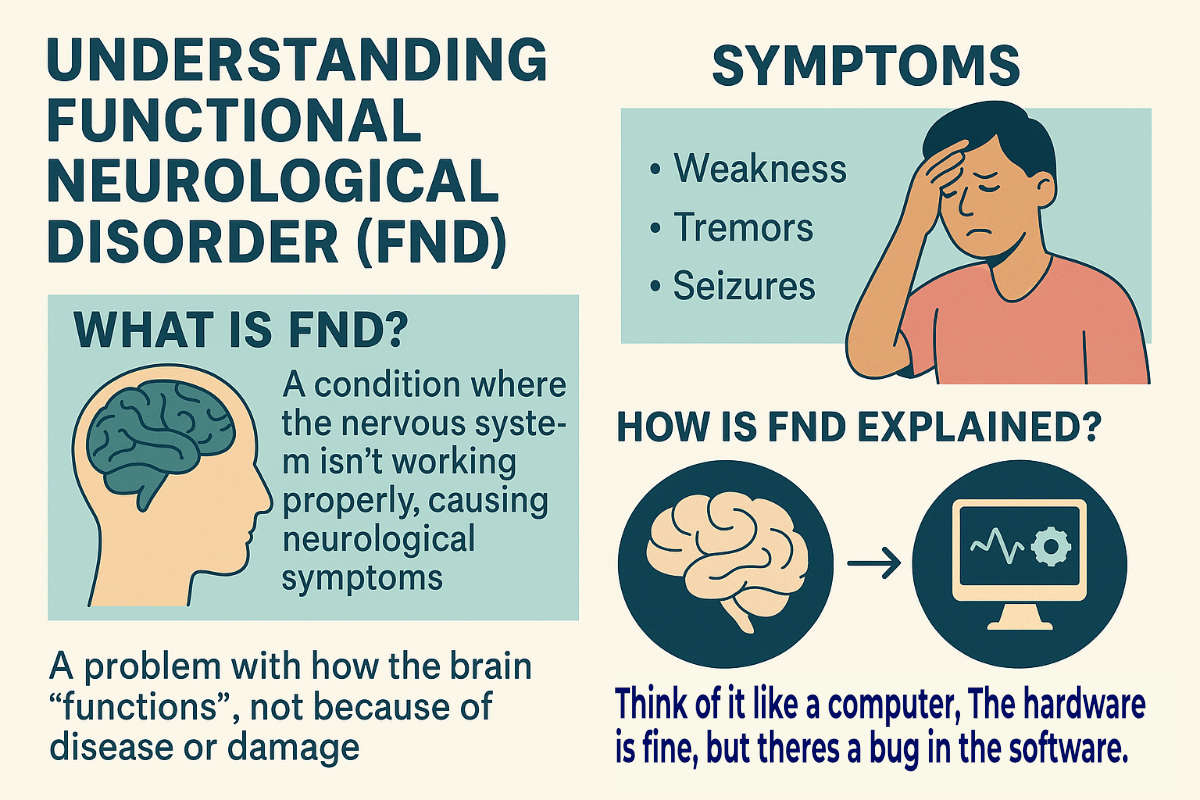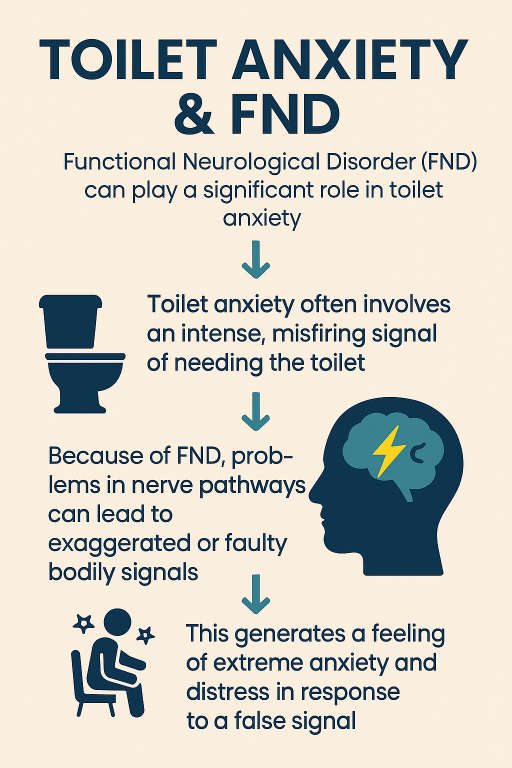Toilet anxiety is one of those things people hardly ever talk about. It’s awkward, it’s personal, and it can feel deeply embarrassing, especially when needing the toilet is a constant fear and that fear becomes so intense it starts to take over your life.
Maybe it’s the constant checking for toilets. Or the creeping dread on a long car journey. Or the way you avoid certain places, just in case.
If that sounds like you, please know this: you’re not alone, and you’re not imagining it.

What’s more, there’s something important that often gets missed in the conversation when people say toilet anxiety ruining my life. It may explain why, despite all the reassurance, distraction techniques, and even therapy you’ve tried, the problem hasn’t shifted, and why your body still reacts the way it does
That “something” is a condition called Functional Neurological Disorder, or FND for short.
Now before you switch off at the medical term, stick with me. This isn’t about labelling you or suggesting there’s something wrong with your brain. It’s quite the opposite. What we’re really talking about is how your brain has learned to respond to certain signals, and how that response has become stuck in an unhelpful loop. Understanding that might be the key to getting your freedom back.
On this page
- So What Is Functional Neurological Disorder?
- Toilet Anxiety and the FND Connection
- Why Many Interventions Fall Short
- That is the FND layer.
- Recovery Starts When You Work With the Pattern, Not Against It
- Why Ignoring the Functional Element Keeps People Stuck
- How We Address the Functional Loop in Toilet Anxiety
- What Recovery Can Really Look Like
- A Final Word
So What Is Functional Neurological Disorder?
Alright, let’s unpack this. Functional Neurological Disorder, or FND, sounds intimidating, like something you’d only hear about in a hospital corridor, whispered by a consultant in a white coat. But at its core, it’s actually quite a human thing. It’s a way of describing symptoms in the body that are very real, but where there’s no damage or disease causing them.

That might sound strange at first. How can something be real if there’s no medical test showing a problem? But think about blushing. Your face goes red when you’re embarrassed, you don’t decide for it to happen, it just does. Or take stage fright. Your hands shake, your voice wobbles, your stomach flips. Again, nothing’s “broken,” but the reaction is still there.
FND is a bit like that, except instead of a passing moment, the brain gets stuck in that misfiring mode. It sends signals that cause the body to act as if something’s wrong, even when it isn’t. Muscles might stop working properly. Sensations might go haywire. For some, it shows up as seizures that look like epilepsy but aren’t. For others, it’s chronic pain, weakness, or even difficulty walking. And for quite a few people… it’s the toilet.
Yes, really.
FND doesn’t just affect limbs or speech. It can affect the gut, the bladder, the nerves that control those deeply private bodily functions. And when it does, it creates symptoms that feel physical, like sudden urgency, spasms, cramps, even the sensation of losing control, but which are actually being driven by an overprotective, overstimulated nervous system.
That’s where it gets interesting.
Toilet Anxiety and the FND Connection

If you’ve lived with toilet anxiety for any length of time, you’ll know that needing the toilet is not “just in your head.” That phrase, often said with a shrug or a sympathetic smile, misses the point entirely. Because the feelings are real. The panic is real. The symptoms, the rush of adrenaline, the tight chest, the gripping sense of urgency, they’re real too.
But what if needing the toilet isn’t anything to do with your bladder or your bowels? What if it’s with the signals your brain is sending and the way your nervous system has learned to respond?
This is where the idea of FND becomes not just relevant, but crucial.
In toilet anxiety, the body starts reacting to certain cues as if they’re threats. It might be being far from a toilet, being on public transport, being stuck in a queue, or even just the thought of needing the toilet and not being able to access a toilet.
Over time, the brain begins to treat these situations as dangerous, triggering the fight or flight system, that’s your sympathetic nervous system, by the way, to jump into action.
The gut and bladder are deeply sensitive to this system. When it’s activated, digestion slows down or speeds up, muscles tighten, and you may suddenly feel like you have to go, even if you just went a few minutes ago. That’s not imagination. That’s neurology. It’s a false alarm triggered by a brain that’s become over-vigilant.
In FND, we often talk about the concept of prediction error, a fancy term that simply means your brain is acting based on what it expects, not necessarily what is happening. If your brain expects danger in a situation where you might end up needing the toilet, it sends signals to your body to prepare, even when you’re perfectly safe. Those signals are often the very symptoms you dread.
Why Many Interventions Fall Short
If you’ve tried to get help for toilet anxiety, you’ve probably come across the usual advice. Plan your routes. Know where the toilets are. Carry a change of clothes. Limit what you drink. Distract yourself. Maybe even breathe slowly and count backwards. Some of it might offer a bit of short-term relief. Most of it doesn’t touch the real problem.
And here is why.
These strategies are all focused on managing the anxiety after it’s already kicked in. They treat the anxiety as if it’s simply about fear, or overthinking. But toilet anxiety, especially the kind that takes over your life, goes deeper than that. It’s not just about needing the toilet, it’s about what your brain and body expect and prepare for automatically.
That is the FND layer.
If your nervous system is wired to predict danger in certain situations, and it reacts with real, physical sensations, then no amount of surface-level reassurance will fully undo that. It’s like trying to talk someone out of blushing. You can’t, because the signal is coming from below conscious awareness.
That’s not to say those coping strategies are useless. They might help reduce the intensity or get you through a tricky moment. But they don’t change the underlying loop, the brain and body loop that has learned to trigger a functional response in the presence of that perceived threat of needing the toilet.
And here is the thing most people don’t realise. If you only ever rely on these surface strategies, you might actually reinforce the loop. You might teach your brain that those situations really are dangerous, and that you can only survive them by avoiding, restricting, or controlling everything around you. Which, understandably, makes the problem worse over time.
Recovery Starts When You Work With the Pattern, Not Against It
So, what actually helps? How do you stop the brain from sending those false alarms, and the body from reacting as if you are under threat every time a toilet isn’t nearby?
It starts by recognising that the problem is not weakness, and it’s not simply anxiety. It’s a learned response, deeply wired into the nervous system, and like anything learned, it can be unlearned. Not by fighting it, but by gently retraining the system to behave differently.
This is exactly why interventions that work at the subconscious level can be so powerful. Because that’s where the loop lives.
When someone with toilet anxiety begins to feel the early signs, a bit of discomfort, a twinge, that creeping thought of “what if”, the body responds before the thinking brain even gets a say. It’s fast, automatic, and often overwhelming. Traditional talk therapy might help make sense of it, but it doesn’t always reach the place where those patterns are stored.
That is where hypnotherapy comes in.
Hypnosis gives you access to the part of your mind that runs those automatic responses, the part that doesn’t care what you know, only what it believes. And if that part has come to believe that being away from a toilet equals danger, then no amount of logic will undo it. What works is changing the belief. Not forcefully, not through positive thinking, but through direct re-patterning of how the brain processes those signals.
It’s about showing your nervous system, repeatedly and safely, that nothing bad is going to happen. That you can experience the sensation of needing the toilet, be in those feared situations, and still stay calm. And slowly, those false alarms begin to fade.
Is it instant? No. Is it magic? Not quite. But it is powerful. And more importantly, it’s a way forward that doesn’t just help you cope, it helps you change.
Why Ignoring the Functional Element Keeps People Stuck
If you take one thing from all this, let it be this. Toilet anxiety is not just a mental fear or a behavioural quirk. It’s NOT about being weak, or overreacting, or needing to toughen up. And it’s not something you can fully fix by gritting your teeth and pushing through.
When the problem includes a functional response, when your brain is triggering physical symptoms based on expectation rather than actual need, then trying to manage it without addressing that mechanism is like painting over a damp wall. It might look okay for a while, but underneath, the real issue is still there, quietly driving everything.
This is why so many people stay stuck, even after trying multiple therapies. They might learn ways to distract themselves, or strategies to avoid triggering situations. But the moment their routine changes, or stress levels rise, or something unpredictable happens, the anxiety returns. Because the system itself was never retrained.
In a way, it’s not that the usual interventions are wrong. They just don’t go far enough. They stop at the surface, when the change needs to happen much deeper, in the way your brain predicts and reacts to the world around you.
That is what makes the functional aspect so important. Once you see it, once you understand that your body is responding to a miscommunication rather than a malfunction, then the whole problem starts to make more sense. And when something makes sense, it becomes treatable.
How We Address the Functional Loop in Toilet Anxiety
If toilet anxiety has a functional element, then treating it properly means going far beyond surface-level techniques. It means working directly with the part of your mind that is triggering the false alarms, and teaching it to respond differently. That is the core of what we do.
We don’t try to distract you from the problem. We don’t encourage endless planning, toilet mapping, or clever tricks to get through the day to avoid the feeling of needing the toilet. Those might help you survive, but they don’t help you recover. Instead, we look at what your brain has learned to expect, and we change those expectations at the source.
That means starting with the pattern, the loop between your thoughts, your nervous system, and your body’s automatic reactions. In a typical session, we gently guide your attention inward, helping you connect with what’s happening beneath the surface. Often, the anxiety is tied to a deep fear of loss of control, embarrassment, or shame. Sometimes, it’s linked to past experiences that your mind has quietly filed away as danger signals.
Using hypnotherapy, we speak directly to the part of your mind that is holding on to those associations. Not by confronting or arguing with it, but by helping it feel safe enough to loosen its grip. Through carefully structured techniques, we begin to teach your brain that you are no longer under threat. That those old signals around needing the toilet are no longer needed.
The process is layered. It’s not about managing symptoms, it’s about transforming how your nervous system responds. Each session is designed to gently disrupt the cycle that keeps the anxiety in place, so that changes begin to take root at a much deeper level.
And it’s not passive. Clients aren’t just sitting back and hoping something changes. The work is real. But it’s also natural. Subtle at first, perhaps, but very real. Bit by bit, people find themselves doing things they thought they couldn’t. Sometimes without even noticing, until afterwards they realise, “I just did that, and it felt okay.”
That is how change happens. Not by tiptoeing around the fear, not by building elaborate strategies to cope, but by helping your mind and body remember what it feels like to be normal again.
What Recovery Can Really Look Like
Recovery isn’t about never feeling anxious again about needing the toilet. It’s not about forcing yourself to be fearless either. It’s about your brain no longer misreading everyday situations as threats. It’s about restoring a natural sense of ease, where the body doesn’t overreact and the mind isn’t on constant alert.
It means being able to leave the house without scanning for toilets. To make plans without that familiar knot of dread. To go about your life without the quiet background panic of needing the toilet and that something might go wrong if you do.
That kind of change happens when the deeper pattern is addressed properly. When the nervous system stops overreacting, and the old wiring begins to fall away. Not by managing or coping, but by shifting how your brain and body behave in the first place.
For many of the people I work with, it’s not a dramatic overnight transformation. It’s steady, sometimes subtle, but unmistakable. One day they realise they did something that used to feel impossible, and it felt normal. Nothing special, nothing rehearsed. Just ordinary again.
If you’re someone who’s been living with toilet anxiety, you may have already tried countless approaches. Some may have helped a little, but if none of them addressed the real root, the functional pattern behind that intense response to needing the toilet, then no wonder things didn’t change in a lasting way.
You didn’t fail. You just haven’t had the right kind of help yet.
A Final Word
If you’ve read this far, you probably know this struggle well. You’ve felt the shame, the fear, the disruption. You’ve worried that maybe this is just how it is now. But it doesn’t have to be. There is more to understand about your symptoms. There is more that can be done.
Toilet anxiety often does have a functional component. And once that is seen for what it is, a nervous system caught in a loop, not a personal flaw, then real, lasting change becomes possible. You don’t have to manage forever. You can retrain. You can heal.
And you’re not alone.
At The Surrey Institute of Clinical Hypnotherapy, I’ve spent over 20 years specialising in the treatment of toilet anxiety. I’m Paul Howard, and I’m proud to be recognised as a pioneer and the world leading specialist in using hypnotherapy for toilet anxiety in order to resolve this deeply misunderstood condition.
My approach doesn’t rely on coping techniques or avoidance strategies. Instead, it focuses on helping the brain return to natural, healthy patterns by breaking the loop that keeps the anxiety alive.
If you’ve tried everything else and nothing has worked, it may be because no one has addressed the real root of the problem. That’s what we do here, and it changes lives.
To find out more or to take the first step, contact us and explore how we can help you move forward with confidence and freedom.
You don’t have to keep living like this. Things really can change.
